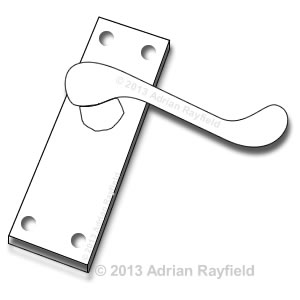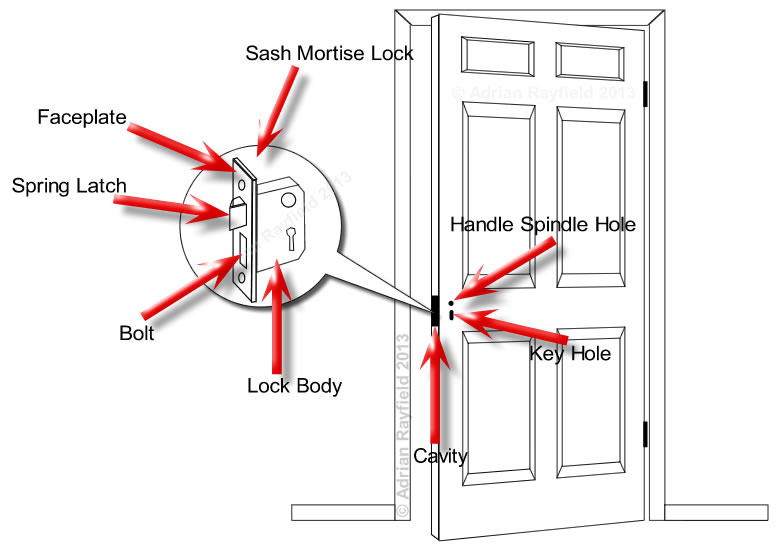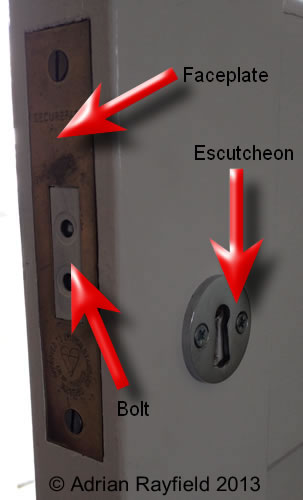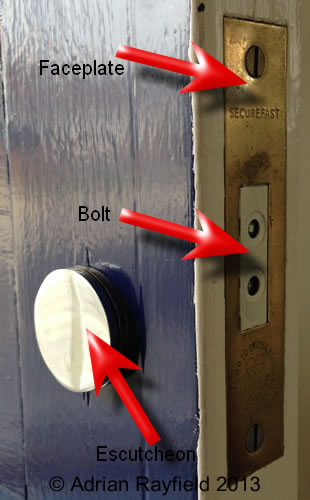Painting, decorating and home improvement tips blog
How to fit door handles or door knob
Posted by Adrian
May 24th, 2020
How to fit door handles or door knob
Once you have fitted a lock such as a mortise sash lock or a cylinder rim lock or are just simply replacing the handles. This post will explain how to do it, it is a fairly simple task and should’t take to long. This post assumes the lock is already fitted to the door and you just need to fit the handles or you are just replacing handles. If you are fitting a new door, you will need to fit a lock first.

As always, you will need to gather the tools you require together before starting the job, you will need:
- A door handle or knob set
- A drill
- A small drill bit
- A screwdriver
- A small level
- A junior hacksaw (possibly required)
Fitting the door handle or door knob
In the door handle pack you should have two handles, fixing screws and a square spindle. Open the pack and put to one side.
Firstly take the spindle and put it through the lock, then take one handle and place it on the spindle.
Now take the level and upright the handle by placing the level on the side of the handle, that is, of course as long as the handle doesn’t have uneven sides or it is a door knob.
When the handle is upright and level, hold it with one hand while you drill two pilot holes, do this for example for the top left and bottom right holes. Then screw the fixing screws in and then drill the final two holes for this handle or knob.
Now take the other handle and try it on the spindle, the spindle maybe too long and requires cutting. Put the second handle on the spindle and see how far the back of the handle is away from the door, you will need cut this amount of the spindle.
Once the spindle has been cut you can fit the second handle, do this the same way as you did the first one. Once all the screws have been screwed in you can try the handle, if the handle stays down without returning to its original position, try loosening the handle fixing screws slightly, this should help. If it doesn’t help, remove one handle and see if the spindle is rubbing on the door where the spindle goes into the lock, if it is remove the spindle and chisel away where it is rubbing, refit the spindle and handle and try again.
Finally, clean off and finger marks off the handle with a soft cloth.
Tags: Cylinder rim lock, Door, Door Handle, Door Knob, Handle, Mortise Sash Lock, Spindle
Posted in Home Improvements | No Comments »
How to fit a mortise deadlock and mortise sash lock
Posted by Adrian
March 19th, 2020

How to fit a mortise deadlock and mortise sash lock
First things first, a mortise deadlock and a mortise sash lock are not exactly the same thing although they are both mortise locks. A mortice lock fits into a recess cut into a door, unlike a cylinder rim lock that fits onto the door. The meaning of mortice is a cavity cut into a piece of wood. You may of heard of mortise and tenon before, this is a woodworking joint, the mortice being the cavity cut into the wood and the tenon is the piece of wood that goes into the cavity or mortice.
Choosing the correct mortice lock
A mortice deadlock can only be opened with a key, it doesn’t have a latch on it. This type of lock has a bolt operated by a key and have great security properties. They have different amount of levers inside them giving them a higher security rating, a 5-lever or British Standard 5-lever conforming to BS3621 or 6-lever locks are ideal for external doors and are often required by house insurance companies, it’s worth checking your policy to be sure. These locks also come as a 3-lever which are more suited for internal doors.
A mortise sash lock is similar to a deadlock is as much as it has a bold, the deadlock part, but also has a latch like a traditional lock. To operate this lock you need a key and a handle. You may find these on front and rear doors on a house. These locks offer security via the dead bolt and convenience via the latch. Again, these lock have different amount of levers inside them, from 2-lever to 5-lever. A 2-lever mortice sash lock is ideal for internal doors or places you need less security.
Fitting both types of lock is done in the same way.
Fitting a mortise lock
Firstly gather the tools required, you will need:
- A mortice lock
- A drill
- Wood drill bits
- A Tape measure
- Chisels
- A pencil
- A door wedge
- Masking tape
Once you have all the tools to hand you can begin to fit the mortice lock. You need to decide the best place for the lock to go, this will depend if it is a mortice deadlock, which can go lower on the door, or a mortice sash lock, which needs to go at a good height to allow for the handle operation.
You should never fit a lock on a joint where a rail (horizontal part) goes into the stile (the vertical part). A good place is in the middle of the centre rail.
Once you have decided on the location of the door, wedge the door open. On the door edge, mark a centre line, then take the lock and place the body of the lock on the edge of the door so you can mark how tall cavity you need to drill out.
Next take a drill and wooden drill bit, measure the depth of the lock and put masking tape on the drill bit that depth, as a guide. Carefully drill on the centre line from top to bottom the depth of the lock being careful not to drill too far in and breaking through the door.
Once you have done this, take a wide wood chisel and tidy up the edges, try the lock into the cavity you have just created, if it doesn’t fit you may have to drill out a bit more or chisel a bit more wood away.
Once the body of the lock fits into the cavity in the door, push the lock into the cavity up to the back of the faceplate, now with a pencil, draw around the faceplate. Then remove the lock and chisel a recess just deep enough for the faceplate to fit into. Chisel around the edge on your pencil mark first. Try the faceplate into the recess by putting the face of the lock into the recess. If you put the lock into the cavity and its a tight fit you will have trouble getting the lock out again. Once your happy the lock and faceplate will fit OK you can then mark out for the other holes to be drilled.
Place the body of the lock on the side of the door with the faceplate flush with the edge of the door, as if it would be if the lock was fitted. Next with a pencil mark the key hole for a mortise deadlock and a key hole and handle spindle hole for a mortise sash lock. Do this both sides of the door. Use a suitable sized wood drill bit and drill the holes from the outside inward on both sides. If you only drill from one side the second hole maybe miss-aligned.
Once you have drilled all the holes fit the lock into the door cavity, once your happy the lock and handles work OK, drill fixing holes on the edge of the door and screw the faceplate into position.
Fitting the lock keep / strike plate
The mortice lock would have come with a keep / strike plate in the kit, most likely a box keep. The keep is the part that goes into the door frame and keeps the door shut or locked. It’s called a box keep as the keep has a box section that the spring latch and or bolt goes into.
To fit the keep, operate the lock so it is in the locked position, then carefully close the door so the bolt and latch if your fitting a mortise sash lock. Mark the frame with a pencil where the top and bottom of the bolt, and latch if you have one, hits the door frame.
Open the door, now place the keep of the frame and align it with the marks, cut out a recess for the box part of the keep, once you have this done fit the keep into the recess and draw around the keep to mark where the actual strike part will go. This will only need to be shallow enough to allow the strike plate to fit into. Once you have done this, drill the holes for it and secure into place.
Trying the lock and keep / strike plate
Once you are happy the door lock works OK it is time to try shutting and locking the door. Close the door and try the latch operation if you have fitted a mortise sash lock. If you fitted a mortise deadlock, close the door and slowly try the bolt, if it catches don’t fully lock the door as you may have trouble getting it open again.
If the bolt caches, paint the end with a bit of paint, or a marker pen or chalk, then close the door and try the lock again, the paint, marker pen or chalk will leave a mark on the keep and you can see where it catches and then adjust the keep and retry it.
Only once you are happy the lock fits OK should you close and lock the door.
Finally you can fit the escutcheon (key hole cover)on both sides of the door. A good way to do this is by placing the escutcheon on the door in the correct position and try the key in the hole, remove the key and drill the first hole, then put the first screw in and then try the key to make sure it goes in and out easily in the hole. Once your happy it does so, drill the second hole and finish screwing the escutcheon on. Then repeat the process on the other side of the door.


Tags: 2-lever, 5-lever, 6-lever, door keep, escutcheon, latch, Lock, mortise deadlock, Mortise Lock, Mortise Sash Lock, strike plate
Posted in Home Improvements | No Comments »
